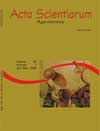<b>Conservação de tangerina cv. <em>Clemenules</em> utilizando diferentes recobrimentos</b> - DOI: 10.4025/actasciagron.v29i1.69
Resumo
O objetivo deste trabalho foi verificar os efeitos de diferentes recobrimentos e períodos de armazenamento na conservação de tangerinas Clemenules. Após a colheita, as frutas foram submetidas ao pré-resfriamento por 12 horas a 5ºC e em seguida, aos seguintes tratamentos: T1) testemunha; T2) filme de polietileno microperfurado; T3) filme de polietileno não perfurado; T4) cera de carnaúba a 50%, diluída em água; T5) cera de carnaúba a 100% (não diluída). As tangerinas foram armazenadas por 20, 40 e 60 dias em temperatura de 5ºC e UR de 90-95%, depois foram mantidas em temperatura de 15±1ºC e UR de 75-80%, durante quatro dias simulando a comercialização. Na colheita e após cada período de armazenamento, seguido de simulação de comercialização, foram avaliadas as variáveis: perda de massa; cor; sólidos solúveis (SS); acidez titulável (AT); relação SS/AT; podridões, distúrbios fisiológicos e características sensoriais. A modificação da atmosfera reduziu a perda de massa, a incidência de distúrbios e podridões de tangerinas Clemenules durante o armazenamento. As frutas acondicionadas em filme de polietileno sem perfuração ou aquelas revestidas com cera sem diluição apresentaram sabor estranho e menor qualidade geral. Tangerinas ‘Clemenules’ acondicionadas em filme de polietileno microperfurado e cera diluída em 50% de água podem ser armazenadas durante 60 dias a 5ºC e comercializadas durante quatro dias a 15±1ºC sem comprometer a qualidade sensorial. Palavras-chave: filme de polietileno, cera, citros, pós-colheita.Downloads
DECLARAÇÃO DE ORIGINALIDADE E DIREITOS AUTORAIS
Declaro que o presente artigo é original, não tendo sido submetido à publicação em qualquer outro periódico nacional ou internacional, quer seja em parte ou em sua totalidade.
Os direitos autorais pertencem exclusivamente aos autores. Os direitos de licenciamento utilizados pelo periódico é a licença Creative Commons Attribution 4.0 (CC BY 4.0): são permitidos o compartilhamento (cópia e distribuição do material em qualqer meio ou formato) e adaptação (remix, transformação e criação de material a partir do conteúdo assim licenciado para quaisquer fins, inclusive comerciais.
Recomenda-se a leitura desse link para maiores informações sobre o tema: fornecimento de créditos e referências de forma correta, entre outros detalhes cruciais para uso adequado do material licenciado.




















































